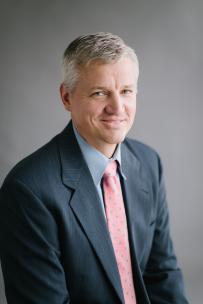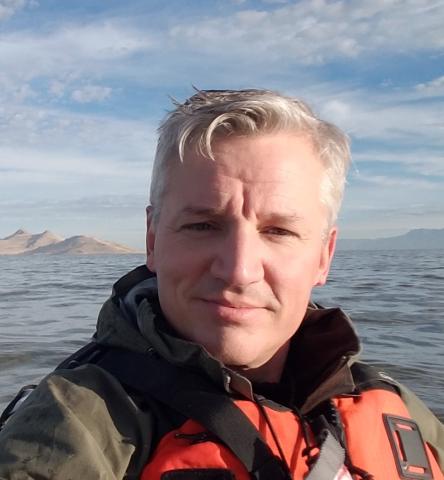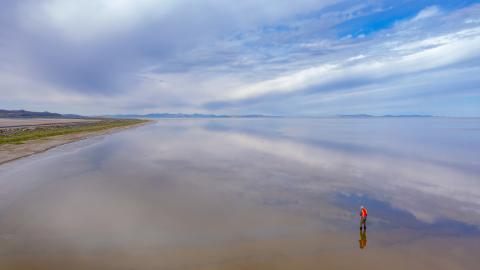Collaboration is often the key to a successful project. For Principal Technologist Jeff DenBleyker, collaboration and cooperation are essential when working on challenging water resource issues. Jeff has worked with numerous diverse stakeholders for most of his career in bringing water resource solutions to Utah and the Colorado River Basin.

We sat down with Jeff to discuss his perspective on collaboration and finding a common goal to achieve success.
Tell me about your journey with Jacobs.
I joined Jacobs in 1996, and initially, my focus was on stormwater. There was a lot of planning and design work, asking ourselves questions like, “what can we do with the excess water we have when it rains?” or “How about when the snow melts in the spring?” As I worked through those issues, I realized that these are not just technical problems to solve but also a critical people component. It wasn’t just about building systems or getting the required permits. We had to listen and address the concerns the communities faced.
Over time, I found the people component very important when I worked on any project. As I worked with private and public entities on their water resource challenges, the solutions for these – whether they were flood control, water supply or water quality problems – centered on the people involved. From there, my career progressed to leading cross-disciplinary groups and often opposing stakeholders into partnerships that could solve their complicated water problems.
Over the past ten years, it has been a natural progression of working with the biggest challenges in water resources in Utah and looking at how water touches every aspect of our lives.
What excites you the most about your current work?
I started my career as a design engineer working on pipelines and dams. What intrigued me most was how challenging and rewarding it was to find a solution that simultaneously solved the technical problem and addressed the goals and needs of the numerous interests often involved. I love finding solutions with a solid basis in science and engineering that can genuinely help impacted communities.
What approaches for water resources planning within challenging environments or communities have been especially helpful?
Water and conflict are unfortunately often seen as synonymous, especially in a water-scarce environment. We are often most passionate about our own needs and perspectives of problems and potential solutions. Those passions and perspectives are usually the sources of conflict – but they can also be the source of lasting, collaborative solutions. Harnessing and using that passion for forging trust and consensus around solutions is the key to a collaborative process built around defensible science and engineering.
We all know that can be hard and messy because it means we must engage with passionate people. We need to listen and discern what everyone is passionate about, distilling that into a central goal or rallying cry. For example, nobody wants to lose their water supply, and they recognize that others probably do not either. Thus, a common goal can be to develop a resilient water supply or prevent legal action. Most, if not all, can agree to that. That becomes our common starting point.
“We are often most passionate about our own needs and perspectives of problems and potential solutions. Those passions and perspectives are usually the sources of conflict – but they can also be the source of lasting, collaborative solutions.”
How can we encourage cooperation between different stakeholders?
Collaboration cannot be all talk. We have to find actions, however small they might be, that we can accomplish together. It allows people to work side-by-side on something less controversial, listening and understanding each other. That builds the kind of trust that is so critical to successful collaboration. We have applied this strategy successfully numerous times here in Utah as we have wrestled with water challenges around the state. It might include investigating a problem or potential solutions, developing datasets that we will all need or implementing a non-controversial project that might not even address the issue. The key is doing it together. Trust is what then enables us to work through the tough stuff.
Can you share an interesting project story?
One of my favorites has been unfolding over the last 15 years. Most of my career has revolved around our challenges with the Great Salt Lake. The lake is in a closed basin, meaning nearly all the water that enters it is from precipitation, and all the water that leaves it is via evaporation. Add a booming economy, fast growth, and a long-term drought and you have all the ingredients for some complicated and contentious many water resource challenges.
I started working on Great Salt Lake issues in 2005. We were investigating the water quality problems in the wetland surrounding the lake's shoreline. That's when I first experienced the intersection between the quantity and quality of water and the effect of conflicting objectives. While the science was undoubtedly fascinating, the water users were the more challenging and rewarding component for me. When I started, attorneys often drove any change because we needed to forge trust among stakeholders. Over time though, through a lot of hard work, we have built that trust and made a lot of progress.
Last year, the lake was at its all-time low; collaboration matters now more than ever. The challenges are more significant and consequential than we have ever faced, and we really need to find lasting solutions that can leave a legacy for future generations.
In a similar vein, where do you see water resource management efforts going in the Lower Colorado River Basin, given the challenges?
With seven states, numerous tribes and an international partner, each composed of their own communities and individuals, water use in the Colorado River Basin is highly complex. It is encouraging to see the states working toward a consensus-driven solution. What I have learned here in Utah, however, is that that is just the beginning. Yes, the states, tribes and federal entities will need to agree. However, every water user throughout the river basin must understand and assume ownership of the solutions for any solution to succeed.
There is no “silver bullet.” There is not even, as a friend says, “silver buckshot or silver birdshot.” We will have to implement a sustainable solution at every corner of the basin for everyone to gain a water supply that is resilient to the climate change and growth that we can expect. This approach is a heavy lift and not for the faint of heart! Through my work in Utah, however, I know it is possible to help conflicting interests recognize a common goal and their role in achieving success. Accomplishing collaboration with even one irrigation company or municipality and replicating that throughout the basin will be the key to a sustainable Colorado River solution.
What is your favorite part of working with the Colorado River Basin community?
My favorite part is the community I have grown to know here in Utah. A lot of the community here relies on the Colorado River for agriculture. Here the towns and the industry revolve around agriculture, and it's been great to listen to and understand their concerns. When we understand people's challenges better, we are better equipped to help create the solution.
You know, everyone wants their farm and their livelihood to succeed. But when we understand the full impacts on the larger community, they are willing, even eager, to find a solution. The community pulls together to make it happen.
What excites you about the future of water resource management?
My entire career, I focused on solving water resources challenges in Utah. It could be that there is a spirit unique to Utah that has enabled us to overcome the seemingly impossible through collaboration. Still, I think we can replicate this experience repeatedly to solve what may seem intractable and impossible water resource problems, no matter the location.
What is one piece of advice you can give someone looking to learn about water resources?
One thing would be to observe. If we're aware of the value of water and the opinions of others in our lives, we can start to make a difference. Every time we turn the faucet on, we should ask ourselves where this is coming from and where it is going. Observe that. Observe the water in our streams and lakes. Look at how we use water each day. That's when we learn how we are all connected to the same system. By observing and becoming aware of how water influences our lives, we realize that water is not something we can compartmentalize. It's a system far bigger than our community.
What is your favorite part of working at #OurJacobs?
That’s easy. My favorite part is the people. My experience has been that we treat everyone equally regardless of rank or expertise. Everyone has value and a seat at the table. Whether we recently hired you or you are a seasoned veteran, every person has a perspective that adds to the project. I always learn something from somebody, and Jacobs is the perfect environment to do that.
About the interviewee

Jeff DenBleyker is a water resources engineer with extensive experience in collaboratively solving some of Utah’s most acute water resource challenges and formulating stakeholder and management strategies. Jeff focuses on helping form solutions that integrate science and engineering with the affected people and uses. He loves the outdoors and exploring the state of Utah with his family.

















































